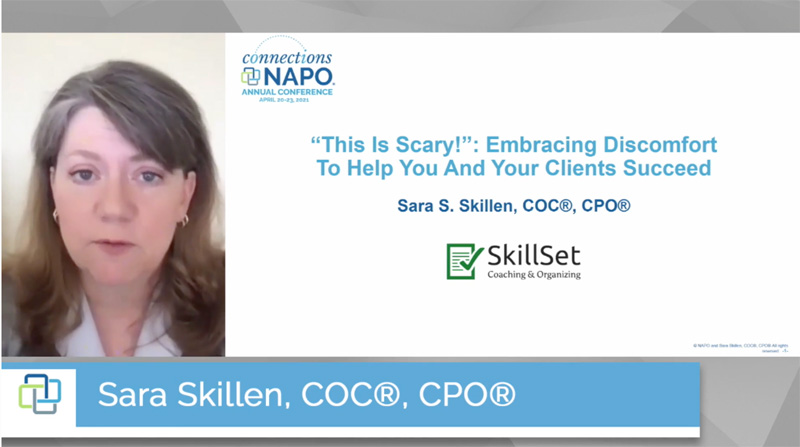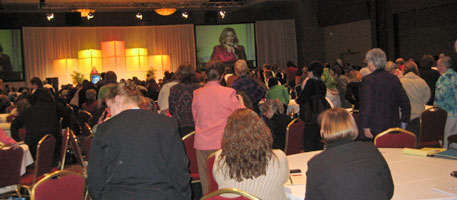Fear: What Impact Does It Have on Your Client Interactions?
This page may contain links to Amazon.com or other sites from which I may receive commission on purchases you make after clicking on such links. Read my full Disclosure Policy

While reading about the presentations at this year’s NAPO Conference, one that especially caught my eye was “This Is Scary” by Sara Skillen as I don’t recall seeing the topic of fear and working with clients covered anywhere before. I invited Sara to share the highlights here on Your Organizing Business.

Imagine something with me for a moment. You’re having a dream in which you enter a large hotel ballroom full of very professional-looking, intelligent, diverse people. Some are chattering away, giving one another big hugs, and others are scoping out the front row seats, perusing handouts, or setting up laptops. More than a few are in line for coffee. Many are shivering from the hotel AC set on “arctic blast” while the song “Happy” plays softly over the PA system. You get up to the front, and someone hooks up your microphone and asks if you need anything. You’re about to give a presentation that you’ve been excited about for months. And then, it happens. You look out into the group and…
Everyone is wearing a mask. Everyone looks unsettled and suspicious, and no one is hugging anymore. The lights are dimming. What the heck? As you stare harder, they all begin to fade away into the darkness, and there’s nothing but screen display monitors looking back at you. You’re alone, except for a screen of your own with some slides pulled up, feeling scared. What on earth are you supposed to do?
Thankfully, you wake up.
We’ve all either had a nightmare about something we planned going awry, or actually experienced it. What do we do with those experiences and discomforts? This spring, I was privileged to present virtually to my esteemed colleagues at the NAPO2021 Annual Conference on one of my favorite topics: fear. The session was initially scheduled for the 2020 Conference, which was canceled due to the pandemic (a nightmare for many who worked so hard on it, I’m sure). I set up the imaginary dream scenario from the first paragraph to illustrate how that felt to me. All of us were disappointed, of course. But we also had the effects of the pandemic on our businesses to manage and navigate – plenty of real-life uncomfortable stuff on our plates.
The original title of my session was “Do Something Scary,” and I was going to focus on the benefits of purposefully getting outside of our comfort zones, either in business or personal lives. But pretty much every colleague I connected with was thrust head-first into scary in 2020 – whether they wanted to be or not. I decided to resubmit, reframe the focus just a bit, and retitle to “This IS Scary: Embracing Discomfort to Help You and Your Clients Succeed.”
The idea is this: by tapping into our own fears and discomforts with intentionality, we can learn about their positive and negative effects. We can deepen our empathetic understanding of how clients may feel about the work we engage in together. Those of us who organize or consult on productivity do it from a place of wanting to help, to make things better for people. And of course, our clients want to make positive changes – that’s why they reach out. But they’re also frequently anxious about how the work will proceed, whether they’ll be embarrassed, whether they’ll be able to maintain the progress. We shouldn’t ignore or push aside that part of the equation in our quest to support them.
No one wants to feel scared or uncomfortable, but the emotions are necessary. They warn us about danger, or give us clues about crossed boundaries, or signal that we need to make a change. My session illustrated the physiology of fear and how it can show up along a continuum – anything from the discomfort of a freezing cold shower to the all-out panic some people feel at the prospect of public speaking. The fear response is automatic and part of our survival mechanism regardless of the stimulus. The point is that telling someone, “Oh, don’t be nervous, you’ll be fine,” is, well…pointless. How many of us have said that in an organizing session, with the best of intentions?
The session also includes:
- Ways to identify uncomfortable situations or stretch goals we can work on, while noting the impact of our fears on those goals;
- Tapping into our scary experiences to be more attuned to the concerns that our clients might feel about the work we do together;
- Results from my informal survey about fears, discomforts, and organizing;
- An “in their own words” section featuring language that can hinder or help an organizing session; and
- Three case studies describing how I’ve worked with clients around their discomfort.
To access the session for yourself, go to https://www.pathlms.com/napo/courses/28323 – there, you’ll find the 65-minute recording and downloadable handouts. Conference attendees can access it for free, NAPO members can purchase it for $15, while non-members can purchase it for $30. And if you really want to dig into the discomfort and fear of organizing, check out my book Organizing and Big Scary Goals: Working With Discomfort and Doubt to Create Real Life Order.
What scary goal would you like to tackle, and what could it teach you?




I often am thrust into something scary, much as you say about 2020. What a crazy and abrupt transition that was! I guess there was the comfort that it was happening to everyone, so it didn’t feel as isolating as other kinds of trials. Terrific session on what to do when fear abounds, whether chosen or unintentional, and what we can say to anxious clients that is actually helpful. Great seeing this here on Janet’s blog!
You make a good point, Seana – the fact we had “shared scary” in this past year did make it a little easier to work with. Maybe that’s something to consider when choosing to face a fear – who else might be in the thick of it too, and is there a way to connect? Thanks for the kind words and the comment!
That’s great advice. How often do we struggle alone when we don’t have to?
And we often think we’re the only person facing the particular fear. Clients often will ask if I know anyone else who has the same experience, feelings, etc. – there’s visible relief when I assure them their challenges are not uncommon.
I attended your session, one of my real highlights of virtual conference. (I even “reported” on it during the conference highlights meeting of my NAPO-Georgia chapter.) I would recommend this session to practitioners (organizers, productivity coaches, and anyone who acts as a change agent with clients) for their client work but also for so many of us for ourselves. Sara, your presentation was compelling. It’s a classic!
Thank you so much, Julie! I’m thrilled that it resonated for you and hope it does for others as well.
Fear is well… terrifying. I have learned to conquer my own fears by just doing it and this has helped when working with clients in the past. Great info and do appreciate the presentation is available to the public.
Thanks so much, Margarita – hope you find the presentation helpful!
Fear usually has to sit with me for a while. Then I figure out what is the scary part or why I am scared and problem solve so I am not so scared I can’t move forward. I read an article that talked about fear and you want to be no more than a 5 out of 10 on a feeling of fear to be able to conquer the challenge. I figure out how to bring the fear down to a 5. When I was trying to decide how to get my course online it was a 10 on the fear scale. Then Janet Barclay suggested I buy a package from her. Whenever I got stuck on building the website for the online course I could send her a question to get help. Having the backup reduced the fear and made it possible to proceed with the project. I try to do that with my clients. When I see they are fearful of starting an organizing project I address the fear and bring the fear down to a manageable level that they can enjoy the challenge but not be paralyzed.
I love you how rate the fear, Julie – giving it a measure also gives it some clarity, like, is this a “I’m being chased by a grizzly bear!” kind of fear or a “I need to hire my first employee” kind of fear. Once there’s a little more clarity the solutions do come easier, as you’ve discovered. And having backup is always key! Thanks for the comment.
Julie, I’m so glad I was able to bring your fear level down! You did a great job on the course site.
I listen to the recording of Sara’s conference presentation. It helped me to consider what some of my clients are going through when we work together. I think a lot of things are done in life because of fear.
First of all, congratulations on presenting your session at the NAPO conference! We all have fear, but it shows up in different ways. Just the other day, I had a discussion with a group of people about our fear of snakes. People shared why they were afraid and where the fear came from. Watching their expressions and body language as they described their fear, I could feel it too. Yet, they also described stories of they faced that fear. And that’s the thing. We can’t ignore the message. The fear response is programmed into us biologically to keep us safe. But we can look at it, work with it, learn from it, and hopefully move on.
When working with clients, fear is often present. Naming and acknowledging is a great first step.